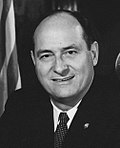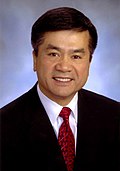Top Qs
Timeline
Chat
Perspective
List of governors of Washington
From Wikipedia, the free encyclopedia
Remove ads
The governor of Washington is the head of government of Washington and commander-in-chief of the state's military forces.[2][3] The officeholder has a duty to enforce state laws,[4] the power to either approve or veto bills passed by the Washington Legislature and line-item veto power to cancel specific provisions in spending bills.[5] The Washington governor may also convene the legislature on "extraordinary occasions".[4]
Washington Territory had 14 territorial governors from its organization in 1853 until the formation of the state of Washington in 1889. Territorial governors were appointed by the president of the United States. Elisha P. Ferry had the longest term of eight years and went on to become the state's first governor. William H. Wallace was appointed governor but never took office due to being elected as the territory's congressional delegate. George Edward Cole was appointed governor and took office, but his appointment was never ratified by the U.S. Senate and he was replaced as governor after four months.
Twenty-two individuals have held the office of Governor of Washington since the state's admission to the Union, with Arthur B. Langlie serving non-consecutive terms. Populist Party candidate John Rankin Rogers is the only non-Democratic or Republican nominee to win office. The most recent governor to be from Eastern Washington was Clarence D. Martin, elected in 1932.[6] The current governor is Democrat Bob Ferguson, who took office on January 15, 2025.
Remove ads
List of governors
Summarize
Perspective
Territory of Washington
Washington Territory was organized on March 2, 1853, from the northern half of Oregon Territory.
State of Washington
Washington was admitted to the Union on November 11, 1889. The term for governor is four years,[2] commencing on the second Monday in the January following the election.[62] If the office of governor is vacant or the governor is unable to discharge their duties, the lieutenant governor assumes the duties of governor, though still officially retains the office of lieutenant governor.[63] If both the offices of governor and lieutenant governor are unable to fulfill their duties, the secretary of state is next in line, and then the treasurer.[64] There is no limit to the number of terms a governor may serve.[65] The office of lieutenant governor is not elected on the same ticket as the governor.
Remove ads
Timeline
| Timeline of Washington governors |
 |
Electoral history (1952–)
Remove ads
See also
Notes
- The range given is from the date the governor was confirmed by the Senate, or appointed by the President during a Senate recess, to the date the governor's successor was confirmed, unless noted.
- Stevens resigned, having been elected to the United States House of Representatives,[7][11] and his successor already appointed.
- James Patton Anderson was nominated on March 12, 1857,[13] and confirmed by the Senate on March 13,[14] but declined.[15] McMullen was appointed on May 13, 1857, during a Senate recess;[12] nominated on December 22, 1857;[16] and confirmed by the Senate on January 18, 1858.[17] He took office on September 10, 1857.[18]
- McMullen left the territory in July 1858, without a formal resignation; the nomination of his successor only notes that the office is vacant.[19] Territorial Secretary Charles H. Mason acted as governor until his successor arrived.[12]
- Gholson left the territory in May 1860 on a leave of absence to move his wife from Texas to Kentucky, and never returned; he formally resigned on February 14, 1861, saying "I am unwilling for even a day to hold office under a (so-called) 'Republican' President."[20] Territorial Secretary Henry McGill acted as governor until his successor arrived.[20]
- Wallace was appointed on April 9, 1861, during a Senate recess;[23] nominated on July 10;[24] and confirmed by the Senate on July 16.[25] However, even though he was a resident of the territory, he never took office; he instead took a seat in the United States House of Representatives that he was elected to on July 8.[23] Territorial Secretary L. Jay S. Turney acted as governor until his successor arrived.[23]
- President Johnson removed Pickering because he had publicly criticized Reconstruction era policies. Territorial Secretary Elwood Evans acted as governor until his successor arrived.
- Cole's nomination was rejected by the Senate on March 1, 1867,[32] and he left office on March 4.[30] Territorial Secretary Elwood Evans acted as governor until his successor arrived.[30]
- Lieutenant governors represented the same party as their governor unless noted.
- Represented the Republican Party
- Hartley lost the Republican nomination to John Arthur Gellatly.
- Martin lost the Democratic nomination to Clarence Dill.
- Represented the Democratic Party
- Ray lost the Democratic nomination to Jim McDermott.
- Ferguson's term will expire on January 8, 2029.
Remove ads
References
External links
Wikiwand - on
Seamless Wikipedia browsing. On steroids.
Remove ads






































